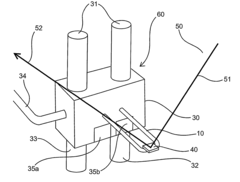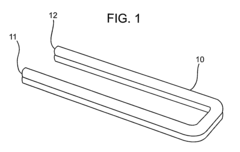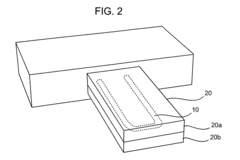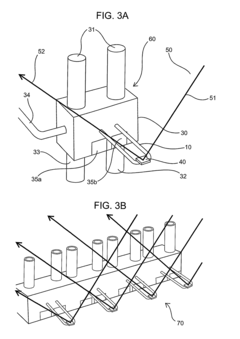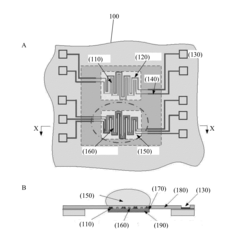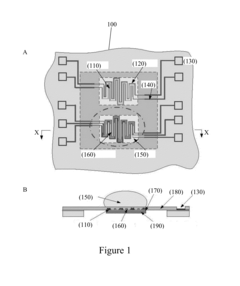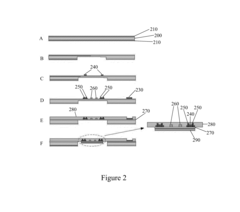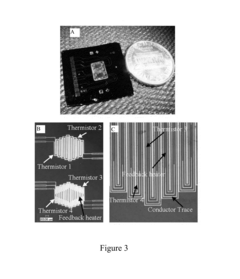How Calorimeters Support Research in Marine Biochemistry
AUG 5, 20259 MIN READ
Generate Your Research Report Instantly with AI Agent
Patsnap Eureka helps you evaluate technical feasibility & market potential.
Calorimetry in Marine Biochemistry: Background and Objectives
Calorimetry has emerged as a crucial tool in marine biochemistry research, offering invaluable insights into the metabolic processes and energy dynamics of marine organisms. The application of calorimetric techniques in this field dates back to the mid-20th century, with significant advancements occurring in recent decades due to technological improvements and increased focus on marine ecosystems.
The primary objective of utilizing calorimetry in marine biochemistry is to quantify and understand the energy transformations occurring within marine organisms and their environments. This encompasses a wide range of studies, from investigating the metabolic rates of individual microorganisms to assessing the energy flow through entire marine food webs. Calorimetry provides researchers with a unique ability to measure heat production directly, offering a comprehensive view of biological processes that may not be apparent through other analytical methods.
As marine ecosystems face unprecedented challenges due to climate change, pollution, and overexploitation, the role of calorimetry in understanding these complex systems has become increasingly critical. Researchers aim to use calorimetric techniques to elucidate how marine organisms adapt to changing environmental conditions, particularly in terms of their energy utilization and metabolic efficiency. This knowledge is essential for predicting the resilience of marine ecosystems and developing effective conservation strategies.
The evolution of calorimetric technology has been marked by a trend towards increased sensitivity, miniaturization, and in situ capabilities. Early calorimeters were limited to laboratory settings, but modern instruments can be deployed in field conditions, allowing for real-time measurements in natural marine environments. This technological progression has opened up new avenues for research, enabling scientists to study organisms in their native habitats and capture data on previously inaccessible marine life forms.
Current research objectives in the field of marine biochemistry calorimetry include developing more sophisticated models of energy flow in marine ecosystems, improving our understanding of the thermodynamics of key biochemical reactions in marine organisms, and exploring the potential of calorimetry in assessing the health of marine environments. Additionally, there is a growing interest in combining calorimetric data with other analytical techniques, such as genomics and proteomics, to create a more comprehensive picture of marine biochemical processes.
As we look to the future, the integration of calorimetry with advanced data analytics and machine learning algorithms promises to unlock new insights into marine biochemistry. These technological synergies may lead to breakthroughs in our ability to predict and mitigate the impacts of global environmental changes on marine life, ultimately contributing to more effective ocean management and conservation efforts.
The primary objective of utilizing calorimetry in marine biochemistry is to quantify and understand the energy transformations occurring within marine organisms and their environments. This encompasses a wide range of studies, from investigating the metabolic rates of individual microorganisms to assessing the energy flow through entire marine food webs. Calorimetry provides researchers with a unique ability to measure heat production directly, offering a comprehensive view of biological processes that may not be apparent through other analytical methods.
As marine ecosystems face unprecedented challenges due to climate change, pollution, and overexploitation, the role of calorimetry in understanding these complex systems has become increasingly critical. Researchers aim to use calorimetric techniques to elucidate how marine organisms adapt to changing environmental conditions, particularly in terms of their energy utilization and metabolic efficiency. This knowledge is essential for predicting the resilience of marine ecosystems and developing effective conservation strategies.
The evolution of calorimetric technology has been marked by a trend towards increased sensitivity, miniaturization, and in situ capabilities. Early calorimeters were limited to laboratory settings, but modern instruments can be deployed in field conditions, allowing for real-time measurements in natural marine environments. This technological progression has opened up new avenues for research, enabling scientists to study organisms in their native habitats and capture data on previously inaccessible marine life forms.
Current research objectives in the field of marine biochemistry calorimetry include developing more sophisticated models of energy flow in marine ecosystems, improving our understanding of the thermodynamics of key biochemical reactions in marine organisms, and exploring the potential of calorimetry in assessing the health of marine environments. Additionally, there is a growing interest in combining calorimetric data with other analytical techniques, such as genomics and proteomics, to create a more comprehensive picture of marine biochemical processes.
As we look to the future, the integration of calorimetry with advanced data analytics and machine learning algorithms promises to unlock new insights into marine biochemistry. These technological synergies may lead to breakthroughs in our ability to predict and mitigate the impacts of global environmental changes on marine life, ultimately contributing to more effective ocean management and conservation efforts.
Market Demand for Calorimetric Analysis in Oceanography
The market demand for calorimetric analysis in oceanography has been steadily growing in recent years, driven by the increasing need for precise measurements of heat flow and energy transfer in marine ecosystems. This demand is fueled by the critical role that calorimetry plays in understanding complex biochemical processes occurring in oceans and their impact on global climate systems.
Oceanographers and marine biochemists are increasingly relying on calorimetric techniques to study various aspects of marine life, including metabolic rates of organisms, energy budgets of ecosystems, and thermodynamics of chemical reactions in seawater. The ability of calorimeters to provide accurate and real-time measurements of heat changes has made them indispensable tools in marine research laboratories and oceanographic expeditions.
One of the key drivers of market demand is the growing concern over climate change and its effects on marine ecosystems. Calorimetric analysis allows researchers to quantify the energy flow within these systems, providing crucial data for climate models and predictions. This has led to increased funding for oceanographic research projects that incorporate calorimetric techniques, further stimulating market growth.
The aquaculture industry has also emerged as a significant contributor to the demand for calorimetric analysis. As the industry expands to meet global food security challenges, there is a growing need for tools to optimize feed formulations, monitor metabolic health of farmed species, and assess the environmental impact of aquaculture operations. Calorimeters offer valuable insights into these areas, driving their adoption in commercial aquaculture settings.
Environmental monitoring agencies and regulatory bodies are another source of market demand. These organizations require accurate measurements of heat flux in marine environments to assess the impact of human activities, such as thermal pollution from industrial discharges or the effects of ocean warming on biodiversity. Calorimetric analysis provides the precision needed for such assessments, leading to increased procurement of calorimetric equipment by government and research institutions.
The pharmaceutical and biotechnology sectors are also contributing to the market demand, as they explore marine organisms for novel bioactive compounds. Calorimetric techniques are essential in studying the thermodynamics of drug-target interactions and evaluating the stability of marine-derived biomolecules, making them valuable tools in marine bioprospecting and drug discovery processes.
As the field of marine biochemistry continues to advance, there is a growing demand for more sophisticated and specialized calorimetric instruments. This includes the development of in situ calorimeters capable of operating in harsh marine environments, as well as high-throughput systems for analyzing large numbers of samples from oceanographic surveys. These technological advancements are expected to further expand the market for calorimetric analysis in oceanography in the coming years.
Oceanographers and marine biochemists are increasingly relying on calorimetric techniques to study various aspects of marine life, including metabolic rates of organisms, energy budgets of ecosystems, and thermodynamics of chemical reactions in seawater. The ability of calorimeters to provide accurate and real-time measurements of heat changes has made them indispensable tools in marine research laboratories and oceanographic expeditions.
One of the key drivers of market demand is the growing concern over climate change and its effects on marine ecosystems. Calorimetric analysis allows researchers to quantify the energy flow within these systems, providing crucial data for climate models and predictions. This has led to increased funding for oceanographic research projects that incorporate calorimetric techniques, further stimulating market growth.
The aquaculture industry has also emerged as a significant contributor to the demand for calorimetric analysis. As the industry expands to meet global food security challenges, there is a growing need for tools to optimize feed formulations, monitor metabolic health of farmed species, and assess the environmental impact of aquaculture operations. Calorimeters offer valuable insights into these areas, driving their adoption in commercial aquaculture settings.
Environmental monitoring agencies and regulatory bodies are another source of market demand. These organizations require accurate measurements of heat flux in marine environments to assess the impact of human activities, such as thermal pollution from industrial discharges or the effects of ocean warming on biodiversity. Calorimetric analysis provides the precision needed for such assessments, leading to increased procurement of calorimetric equipment by government and research institutions.
The pharmaceutical and biotechnology sectors are also contributing to the market demand, as they explore marine organisms for novel bioactive compounds. Calorimetric techniques are essential in studying the thermodynamics of drug-target interactions and evaluating the stability of marine-derived biomolecules, making them valuable tools in marine bioprospecting and drug discovery processes.
As the field of marine biochemistry continues to advance, there is a growing demand for more sophisticated and specialized calorimetric instruments. This includes the development of in situ calorimeters capable of operating in harsh marine environments, as well as high-throughput systems for analyzing large numbers of samples from oceanographic surveys. These technological advancements are expected to further expand the market for calorimetric analysis in oceanography in the coming years.
Current Challenges in Marine Biochemical Calorimetry
Marine biochemical calorimetry faces several significant challenges that hinder its full potential in supporting research in marine biochemistry. One of the primary obstacles is the complexity of marine environments, which introduces numerous variables that can affect calorimetric measurements. Fluctuations in temperature, pressure, and salinity in marine ecosystems can significantly impact the accuracy and reproducibility of calorimetric data.
The miniaturization of calorimetric devices for in situ measurements presents another major challenge. Current calorimeters are often too large and cumbersome for deployment in marine environments, limiting their use to laboratory settings. This restriction prevents real-time analysis of biochemical processes in their natural marine habitats, potentially missing crucial dynamic interactions and environmental influences.
Sensitivity and detection limits of calorimeters pose additional challenges when dealing with dilute marine samples. Many biochemical processes in marine environments occur at very low concentrations, requiring highly sensitive instruments to detect and measure the associated heat changes. Improving the sensitivity of calorimeters while maintaining their robustness for marine applications remains a significant technical hurdle.
The presence of interfering substances in seawater, such as dissolved organic matter and inorganic ions, can complicate calorimetric measurements. These substances may interact with the analytes of interest or affect the heat transfer processes, leading to potential artifacts or misinterpretations of the data. Developing methods to isolate or account for these interferences is crucial for obtaining reliable results in marine biochemical calorimetry.
Long-term stability and corrosion resistance of calorimetric instruments in marine environments present ongoing challenges. Exposure to saltwater and marine organisms can degrade instrument components over time, affecting measurement accuracy and instrument longevity. Designing calorimeters with materials and coatings that can withstand these harsh conditions without compromising performance is an area of active research and development.
Data interpretation and analysis in marine biochemical calorimetry also face challenges due to the complexity of marine systems. Distinguishing between multiple simultaneous biochemical processes and accurately attributing heat changes to specific reactions or interactions can be difficult. Advanced data analysis techniques and modeling approaches are needed to deconvolute complex calorimetric signals and extract meaningful biochemical information from marine samples.
Lastly, standardization and calibration of calorimetric measurements in marine biochemistry remain challenging. The lack of universally accepted protocols and reference materials specific to marine environments hinders the comparability of results across different studies and laboratories. Establishing standardized procedures and developing appropriate calibration standards for marine biochemical calorimetry is essential for advancing the field and ensuring the reliability and reproducibility of research findings.
The miniaturization of calorimetric devices for in situ measurements presents another major challenge. Current calorimeters are often too large and cumbersome for deployment in marine environments, limiting their use to laboratory settings. This restriction prevents real-time analysis of biochemical processes in their natural marine habitats, potentially missing crucial dynamic interactions and environmental influences.
Sensitivity and detection limits of calorimeters pose additional challenges when dealing with dilute marine samples. Many biochemical processes in marine environments occur at very low concentrations, requiring highly sensitive instruments to detect and measure the associated heat changes. Improving the sensitivity of calorimeters while maintaining their robustness for marine applications remains a significant technical hurdle.
The presence of interfering substances in seawater, such as dissolved organic matter and inorganic ions, can complicate calorimetric measurements. These substances may interact with the analytes of interest or affect the heat transfer processes, leading to potential artifacts or misinterpretations of the data. Developing methods to isolate or account for these interferences is crucial for obtaining reliable results in marine biochemical calorimetry.
Long-term stability and corrosion resistance of calorimetric instruments in marine environments present ongoing challenges. Exposure to saltwater and marine organisms can degrade instrument components over time, affecting measurement accuracy and instrument longevity. Designing calorimeters with materials and coatings that can withstand these harsh conditions without compromising performance is an area of active research and development.
Data interpretation and analysis in marine biochemical calorimetry also face challenges due to the complexity of marine systems. Distinguishing between multiple simultaneous biochemical processes and accurately attributing heat changes to specific reactions or interactions can be difficult. Advanced data analysis techniques and modeling approaches are needed to deconvolute complex calorimetric signals and extract meaningful biochemical information from marine samples.
Lastly, standardization and calibration of calorimetric measurements in marine biochemistry remain challenging. The lack of universally accepted protocols and reference materials specific to marine environments hinders the comparability of results across different studies and laboratories. Establishing standardized procedures and developing appropriate calibration standards for marine biochemical calorimetry is essential for advancing the field and ensuring the reliability and reproducibility of research findings.
Existing Calorimetric Methods for Marine Biochemical Studies
01 Design improvements in calorimeter construction
Various improvements in the design and construction of calorimeters have been developed to enhance their accuracy and efficiency. These improvements include modifications to the calorimeter body, insulation techniques, and the integration of advanced materials to minimize heat loss and improve measurement precision.- Design improvements in calorimeter construction: Various improvements in the design and construction of calorimeters have been developed to enhance their accuracy and efficiency. These improvements include modifications to the structure, materials used, and overall layout of the calorimeter components. Such advancements aim to minimize heat loss, improve insulation, and increase the precision of measurements.
- Specialized calorimeters for specific applications: Calorimeters have been developed for specific applications in various fields, such as industrial processes, scientific research, and material testing. These specialized calorimeters are designed to meet the unique requirements of their intended use, incorporating features tailored to the particular measurement needs of the application.
- Advancements in calorimeter measurement techniques: Innovations in measurement techniques have been introduced to improve the accuracy and reliability of calorimetric measurements. These advancements include new methods for sample preparation, data collection, and analysis, as well as the integration of advanced sensors and control systems to enhance the overall performance of calorimeters.
- Integration of digital technology in calorimetry: The incorporation of digital technology and automation in calorimetry has led to significant improvements in data acquisition, processing, and analysis. Modern calorimeters often feature computerized control systems, digital displays, and advanced software for real-time monitoring and data interpretation, enhancing the efficiency and accuracy of measurements.
- Historical developments in calorimeter design: The evolution of calorimeter design has seen numerous improvements and innovations over time. Early calorimeters underwent various modifications to enhance their accuracy and usability, including changes in materials, insulation techniques, and measurement methods. These historical developments have contributed to the advancement of modern calorimetry.
02 Specialized calorimeters for specific applications
Calorimeters have been developed for specific applications, such as measuring the heat of combustion of fuels, determining the thermal properties of materials, or analyzing chemical reactions. These specialized calorimeters are designed to meet the unique requirements of different industries and research fields.Expand Specific Solutions03 Integration of digital technology in calorimetry
Modern calorimeters incorporate digital technology for data acquisition, processing, and analysis. This integration allows for more accurate measurements, real-time monitoring, and automated control of experimental conditions, enhancing the overall performance and usability of calorimetric systems.Expand Specific Solutions04 Advancements in calorimeter calibration methods
Improved calibration methods have been developed to ensure the accuracy and reliability of calorimetric measurements. These advancements include new calibration standards, automated calibration procedures, and techniques for compensating for environmental factors that may affect measurement results.Expand Specific Solutions05 Miniaturization and portability of calorimeters
Efforts have been made to develop smaller, more portable calorimeters for field use and on-site measurements. These compact designs maintain measurement accuracy while offering increased flexibility and convenience for applications outside of traditional laboratory settings.Expand Specific Solutions
Key Players in Marine Calorimetry Instrumentation
The field of calorimetry in marine biochemistry research is in a growth phase, with increasing market size and technological advancements. The global market for calorimetry instruments is expanding, driven by the rising demand for precise thermal analysis in various scientific disciplines, including marine biochemistry. While the technology is relatively mature, ongoing innovations are enhancing its capabilities and applications. Key players in this space include established research institutions like the California Institute of Technology and Ocean University of China, as well as commercial entities such as LECO Corp. and Mettler-Toledo GmbH. These organizations are contributing to the development of more sophisticated calorimetry tools, improving sensitivity, accuracy, and automation for marine biochemical studies.
Institute of Oceanology
Technical Solution: The Institute of Oceanology has developed advanced calorimetry techniques for marine biochemistry research. They utilize differential scanning calorimetry (DSC) to study the thermal stability and folding of marine proteins[1]. Their calorimeters can measure heat changes as small as 0.1 μcal, allowing for precise analysis of biochemical reactions in seawater samples[2]. The institute has also pioneered the use of isothermal titration calorimetry (ITC) to investigate ligand-binding interactions in marine organisms, providing insights into adaptation mechanisms to extreme ocean environments[3]. Their calorimetry methods have been applied to study the effects of ocean acidification on marine calcifiers, measuring the energetics of calcium carbonate formation under varying pH conditions[4].
Strengths: High sensitivity for detecting subtle biochemical changes in marine samples; expertise in applying calorimetry to diverse marine research questions. Weaknesses: Potential limitations in analyzing complex mixtures typical in seawater; may require specialized sample preparation techniques for marine specimens.
Ocean University of China
Technical Solution: Ocean University of China has developed innovative calorimetry applications for marine biochemistry. They employ microcalorimetry to study metabolic activities of marine microorganisms, measuring heat production rates as low as 0.1 μW[5]. Their researchers have adapted isothermal titration calorimetry (ITC) for investigating protein-ligand interactions in marine toxins, providing crucial data for understanding harmful algal blooms[6]. The university has also pioneered the use of flow calorimetry to analyze enzymatic reactions in seawater, allowing real-time monitoring of biochemical processes under simulated ocean conditions[7]. Their calorimetric methods have been applied to study the thermodynamics of marine polysaccharide degradation, offering insights into carbon cycling in marine ecosystems[8].
Strengths: Specialized expertise in adapting calorimetry for marine-specific applications; integration of calorimetry with other oceanographic techniques. Weaknesses: Possible challenges in scaling up methods for large-volume seawater analysis; may face difficulties in maintaining calibration accuracy in field conditions.
Innovative Calorimetric Approaches in Marine Biochemistry
Calorimeter and methods of use thereof
PatentInactiveUS20070189920A1
Innovation
- A calorimeter device with a U-shaped reaction vessel and sensors that detect temperature changes through mechanical, electrical, or resonance property changes, allowing for precise measurement of heat input or output, and featuring a system for automated analysis and data management.
Ultrasensitive, superfast, and microliter-volume differential scanning nanocalorimeter for direct charactization of biomolecular interactions
PatentInactiveUS20130344612A1
Innovation
- A differential scanning nanocalorimeter with a free-standing polymer diaphragm and microthermistor design, capable of measuring thermal fluctuations of 10 μK or less, using a microthermistor trace sandwiched between electrically conductive traces and a copper island for improved thermal isolation and sensitivity, allowing for small sample sizes and rapid measurements.
Environmental Impact of Calorimetric Research in Oceans
Calorimetric research in marine environments has both direct and indirect impacts on oceanic ecosystems. The deployment of calorimeters in marine settings requires careful consideration of potential environmental consequences. While these instruments provide valuable data for marine biochemistry studies, their presence and operation can affect local marine life and habitats.
One primary concern is the physical disturbance caused by the installation and maintenance of calorimetric equipment. Anchoring systems and support structures may disrupt benthic communities and alter seafloor topography. This can lead to changes in local species composition and abundance, particularly in sensitive habitats such as coral reefs or seagrass beds.
The introduction of artificial materials associated with calorimeters can also impact marine ecosystems. Metals, plastics, and other synthetic components may leach chemicals into the surrounding water, potentially affecting water quality and marine organisms. Additionally, these structures can serve as artificial reefs, attracting and concentrating marine life in ways that may disrupt natural ecological balances.
Electromagnetic fields generated by calorimetric instruments and their power sources may influence the behavior of marine organisms, particularly those that rely on electromagnetic sensing for navigation or prey detection. While the effects are generally localized, they could potentially alter the movement patterns and distribution of certain species in the vicinity of research sites.
The acoustic emissions from calorimeters and associated equipment can contribute to underwater noise pollution. This may interfere with marine animal communication, navigation, and feeding behaviors, especially for species that rely heavily on sound, such as cetaceans and some fish species.
On a broader scale, the data collected through calorimetric research contributes to our understanding of marine biochemical processes and their responses to environmental changes. This knowledge is crucial for developing effective conservation strategies and predicting the impacts of climate change on ocean ecosystems. In this sense, the environmental impact of calorimetric research extends beyond immediate physical effects to inform policies and practices that can have far-reaching consequences for marine environments.
It is important to note that the severity of these impacts can vary greatly depending on the scale of deployment, the specific technologies used, and the sensitivity of the marine environment in question. Researchers and environmental managers must carefully weigh the scientific benefits against potential ecological costs when planning and executing calorimetric studies in marine settings.
One primary concern is the physical disturbance caused by the installation and maintenance of calorimetric equipment. Anchoring systems and support structures may disrupt benthic communities and alter seafloor topography. This can lead to changes in local species composition and abundance, particularly in sensitive habitats such as coral reefs or seagrass beds.
The introduction of artificial materials associated with calorimeters can also impact marine ecosystems. Metals, plastics, and other synthetic components may leach chemicals into the surrounding water, potentially affecting water quality and marine organisms. Additionally, these structures can serve as artificial reefs, attracting and concentrating marine life in ways that may disrupt natural ecological balances.
Electromagnetic fields generated by calorimetric instruments and their power sources may influence the behavior of marine organisms, particularly those that rely on electromagnetic sensing for navigation or prey detection. While the effects are generally localized, they could potentially alter the movement patterns and distribution of certain species in the vicinity of research sites.
The acoustic emissions from calorimeters and associated equipment can contribute to underwater noise pollution. This may interfere with marine animal communication, navigation, and feeding behaviors, especially for species that rely heavily on sound, such as cetaceans and some fish species.
On a broader scale, the data collected through calorimetric research contributes to our understanding of marine biochemical processes and their responses to environmental changes. This knowledge is crucial for developing effective conservation strategies and predicting the impacts of climate change on ocean ecosystems. In this sense, the environmental impact of calorimetric research extends beyond immediate physical effects to inform policies and practices that can have far-reaching consequences for marine environments.
It is important to note that the severity of these impacts can vary greatly depending on the scale of deployment, the specific technologies used, and the sensitivity of the marine environment in question. Researchers and environmental managers must carefully weigh the scientific benefits against potential ecological costs when planning and executing calorimetric studies in marine settings.
Data Integration and Analysis in Marine Calorimetry
Data integration and analysis in marine calorimetry play a crucial role in advancing research in marine biochemistry. The integration of calorimetric data with other oceanographic and biochemical measurements provides a comprehensive understanding of marine ecosystems and their underlying processes.
Calorimeters generate vast amounts of data on heat production and consumption in marine organisms and environments. This data must be carefully integrated with other parameters such as temperature, salinity, pH, and nutrient concentrations to provide a holistic view of marine biochemical processes. Advanced data integration techniques, including machine learning algorithms and artificial intelligence, are increasingly being employed to handle the complexity and volume of data generated in marine calorimetry studies.
The analysis of integrated calorimetric data involves sophisticated statistical methods and modeling approaches. Time series analysis is often used to identify patterns and trends in heat flux measurements over different temporal scales. Multivariate analysis techniques, such as principal component analysis and canonical correlation analysis, help researchers uncover relationships between calorimetric data and other environmental variables.
Spatial analysis of calorimetric data is another important aspect of marine biochemistry research. Geographic information systems (GIS) and remote sensing technologies are used to map heat flux patterns across marine ecosystems, providing insights into the spatial distribution of metabolic activities and their relationship to oceanographic features.
Data visualization plays a critical role in interpreting and communicating the results of marine calorimetry studies. Interactive dashboards and 3D visualization tools allow researchers to explore complex datasets and identify patterns that may not be apparent through traditional analytical methods. These tools are particularly valuable for presenting findings to policymakers and stakeholders involved in marine conservation efforts.
The integration of calorimetric data with -omics data (genomics, proteomics, metabolomics) is an emerging frontier in marine biochemistry research. This integration allows researchers to link heat production and consumption patterns with specific molecular processes, providing a deeper understanding of the mechanisms underlying marine organism responses to environmental changes.
Challenges in data integration and analysis for marine calorimetry include dealing with data heterogeneity, managing large datasets, and ensuring data quality and consistency across different measurement platforms. Efforts to standardize data formats and develop shared databases are ongoing to facilitate collaboration and data sharing among marine researchers worldwide.
Calorimeters generate vast amounts of data on heat production and consumption in marine organisms and environments. This data must be carefully integrated with other parameters such as temperature, salinity, pH, and nutrient concentrations to provide a holistic view of marine biochemical processes. Advanced data integration techniques, including machine learning algorithms and artificial intelligence, are increasingly being employed to handle the complexity and volume of data generated in marine calorimetry studies.
The analysis of integrated calorimetric data involves sophisticated statistical methods and modeling approaches. Time series analysis is often used to identify patterns and trends in heat flux measurements over different temporal scales. Multivariate analysis techniques, such as principal component analysis and canonical correlation analysis, help researchers uncover relationships between calorimetric data and other environmental variables.
Spatial analysis of calorimetric data is another important aspect of marine biochemistry research. Geographic information systems (GIS) and remote sensing technologies are used to map heat flux patterns across marine ecosystems, providing insights into the spatial distribution of metabolic activities and their relationship to oceanographic features.
Data visualization plays a critical role in interpreting and communicating the results of marine calorimetry studies. Interactive dashboards and 3D visualization tools allow researchers to explore complex datasets and identify patterns that may not be apparent through traditional analytical methods. These tools are particularly valuable for presenting findings to policymakers and stakeholders involved in marine conservation efforts.
The integration of calorimetric data with -omics data (genomics, proteomics, metabolomics) is an emerging frontier in marine biochemistry research. This integration allows researchers to link heat production and consumption patterns with specific molecular processes, providing a deeper understanding of the mechanisms underlying marine organism responses to environmental changes.
Challenges in data integration and analysis for marine calorimetry include dealing with data heterogeneity, managing large datasets, and ensuring data quality and consistency across different measurement platforms. Efforts to standardize data formats and develop shared databases are ongoing to facilitate collaboration and data sharing among marine researchers worldwide.
Unlock deeper insights with Patsnap Eureka Quick Research — get a full tech report to explore trends and direct your research. Try now!
Generate Your Research Report Instantly with AI Agent
Supercharge your innovation with Patsnap Eureka AI Agent Platform!
